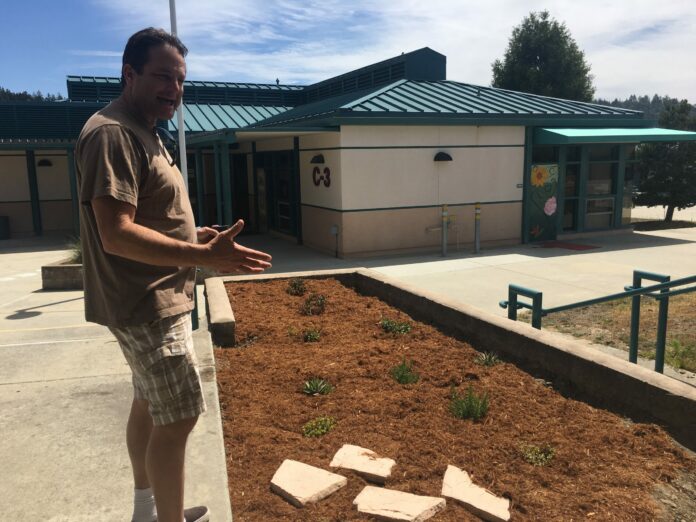Scotts Valley High School is transforming into an eco-friendly, sustainable campus, with the assistance of the “Green Team.”
The idea behind the “Green Team” comes from Mark Andrews, an environmental science teacher at SVHS. Andrews teaches environmental and biology classes, aimed at having students working on projects such as creating a sustainable organic garden, landscaping areas of the school with native plants and making water catch systems to reuse rain water.
“The project evolved as a way to get the kids out of the classrooms and working in environmental science,” Andrews said. “It is also creating a model that the city and students at home can follow.”
In 2016, Andrews and students in his classes worked on building a school garden that included a water catch system. Over the last year, the garden saw its first harvest providing kale and lettuce to the cafeteria. Now the garden is seeded and planted with tomatoes. Andrews teaches students how to work with different soils, the importance of using native plants and gardening—a lost art, according to Andrews.
Additionally, Andrews and the “Green Team” received a grant from the National Oceanic and Atmospheric Administration (NOAA) and the Scotts Valley Rotary Club to conduct multiple marine debris cleanups at local beaches. The environmental science and marine biology classes went on field trips to collect debris from the beaches and record local data in NOAA’s database.
At last week’s city council meeting, SVHS students from Andrews’ classes presented their findings from the field trips. In one cleanup day at Davenport beach, students picked up 228 lbs. of trash and 16 lbs. of recycling.
“NOAA is leading the charge in reducing all forms of waste from reaching our oceans by educating the local communities, via students like ours at SVHS,” Andrews said. “Beach cleanups are reactive actions, but we can also address the problem by eliminating items such as single-use plastic bottles, utensils, and straws, as well as synthetic chemicals like fertilizers like Miracle-Gro, pesticides, and herbicides like Round-Up (proactive/preventative actions). These all serve to pollute and poison our waterways, watersheds, and oceans and if not stopped, will ultimately lead to an unsafe and unhealthy environment for all of us.”
The SVHS “Green Team” expands to more than just the science classes. The foreign language, math, physics and art departments have all contributed pieces to the vision Andrews has crafted.
“Being in this class (environmental science) has opened up my mind,” said SVHS senior Sophie Chiara. “It is interesting to see how small projects like this can really transform the campus.”
Chiara explained her and her teammates were responsible for raising money to get the supplies for the landscape project. She started a GoFundme campaign and raised almost $300. According to Andrews, a key part of the project is having the students organize and fundraise to get their own materials to do the work.
“It was a cool experience to see how willing people are to invest a small amount of money into projects like this,” Chiara said. After graduating Chiara said she will spend a year or two studying at Cabrillo College and is interested in environmental studies.
According to Andrews, the project and “Green Team” will only continue to expand to other areas of the campus still in need of landscaping. He hopes to build a larger compost area, a bigger water catch system and decorate the campus with environmental facts and statements.
Andrews enthusiasm for the “Green Team” is apparent as his face lights up when he greets students on campus wanting to discuss their projects.
“The biggest thing I think these kids will learn is stewardship,” Andrews said. “Nothing is easy. Sometimes you have to go the extra mile, but it is worth it.”












